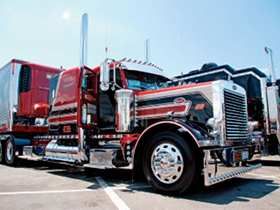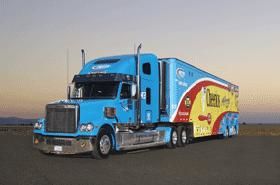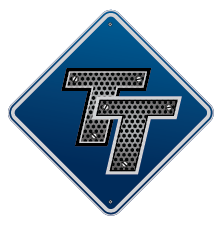CDL School - Backing Troubles
Topic 26570 | Page 1
Take your time. Pay attention to which way the rear end of the trailer is going. So much of this is experience. I know that doesn't help right now. But if you have time to play around with the steering wheel to see how the trailer reacts. You don't have to crank the wheel go slow and turn the steering wheel slowly and pay attention to what is happening. I have watched several old timers and it just seemed like it was taking them forever but guess what they never had to do a pull-up. Then I watch these Cowboys try to do it in 10 seconds. And of course they do it but it doesn't matter as long as you get it the hole. Keep working on it brother good luck.
Sorry to hear about the backing problems, but JOIN THE CLUB, Moses!! Backing the offset, and especially that 90 is where most CDL students start to go crazy.
You can use the search bar at the top (the blank space under the Trucking Truth title) and search on offset or "alley dock".
A few key thoughts, one your instructor hinted at: that you "wait too long". At the beginning it seems almost too subtle. But watch the side of the trailer and watch it bend (turning on the 5th wheel) "one inch of bend will turn into one foot change in no time". Also, the saying goes that when you turn the steering wheel as you back up, it takes 10 feet in backing for the tandems to get the message.
You are not alone, Moses. You are getting frustrated. And that's par for the course. Each time you back up, analyze what you did to mess up and make it a learning experience for your next try. Then focus on getting it right next time.
CDL:
Commercial Driver's License (CDL)
A CDL is required to drive any of the following vehicles:
- Any combination of vehicles with a gross combined weight rating (GCWR) of 26,001 or more pounds, providing the gross vehicle weight rating (GVWR) of the vehicle being towed is in excess of 10,000 pounds.
- Any single vehicle with a GVWR of 26,001 or more pounds, or any such vehicle towing another not in excess of 10,000 pounds.
- Any vehicle, regardless of size, designed to transport 16 or more persons, including the driver.
- Any vehicle required by federal regulations to be placarded while transporting hazardous materials.
Tandems:
Tandem Axles
A set of axles spaced close together, legally defined as more than 40 and less than 96 inches apart by the USDOT. Drivers tend to refer to the tandem axles on their trailer as just "tandems". You might hear a driver say, "I'm 400 pounds overweight on my tandems", referring to his trailer tandems, not his tractor tandems. Tractor tandems are generally just referred to as "drives" which is short for "drive axles".
Tandem:
Tandem Axles
A set of axles spaced close together, legally defined as more than 40 and less than 96 inches apart by the USDOT. Drivers tend to refer to the tandem axles on their trailer as just "tandems". You might hear a driver say, "I'm 400 pounds overweight on my tandems", referring to his trailer tandems, not his tractor tandems. Tractor tandems are generally just referred to as "drives" which is short for "drive axles".

The offset is challenging at my school. Unlike the generous 140' of room from the cones to the boundary, as shown in all those youtube videos for CDL tests, we are given "a truck and half" length, which is about 110' iirc. That 30' makes a difference! You cannot simply crank one way until you see the far side of the landing gear, then crank the other way until the unit is lined up with itself and the target hole, you'll run over cones before the unit aligns. So a pull up is required. Since I am using different trucks at times, I have learned that the "count to 3" or "count to 5" method is not a consistent winner, so I have started using the angle of the tractor:trailer. For consistency I rely on how much of my landing gear is visible in my mirror. That's a big part of my system. And I believe a system is important because you need to be able to reproduce success on test day.
For example, my system for a left to right offset is: 1) Drive out and put the nose of the tractor right on the boundary. This is where the test starts. 2) Crank the wheel all the way to the left. 4) Start backing and continue until the far side of the landing gear just comes into view. Stop. 5) Crank the wheel all the way to the right. 6) Back until I am out of room at the cones. Stop. GOAL if you think you might have more room to back. Use it all. My tractor:trailer are never in line here, because of the limited room. 7) Turn the wheel back until you're steering a bit left. 8) Pull up to the boundary, adjusting your steering to get the unit straight. This is where the art comes in. You want to use left and right to get both alignment of the unit, and get the lowest entry angle to your target hole. An ideal. 9) You should now have a good view of your target hole, at least the inside cone, on the driver's side (which is why I'm picking L to R for test day), and have a rather shallow angle straight back to do from there.
Of course it's all different out irl, because so many other variables are often present, cars, poles, etc. But at least out there you don't have to count your pull ups!
TLDR: use the same steps throughout your tries, evaluate what went wrong, and adjust the steps until you have a working system. It's all geometry.
CDL:
Commercial Driver's License (CDL)
A CDL is required to drive any of the following vehicles:
- Any combination of vehicles with a gross combined weight rating (GCWR) of 26,001 or more pounds, providing the gross vehicle weight rating (GVWR) of the vehicle being towed is in excess of 10,000 pounds.
- Any single vehicle with a GVWR of 26,001 or more pounds, or any such vehicle towing another not in excess of 10,000 pounds.
- Any vehicle, regardless of size, designed to transport 16 or more persons, including the driver.
- Any vehicle required by federal regulations to be placarded while transporting hazardous materials.
HOS:
Hours Of Service
HOS refers to the logbook hours of service regulations.
Thank you all I am reading and digesting the information for now. At some point this will all click. Pretrip and Air Brakes test clicked for me, as did 10 speed manual shifting and down shifting rpms etc, same with gauging how wide to take my turns , things are clicking at the right time it seems.
I am confident that this will at the right time. Sooner than later I hope lol.
Trucking as been my boot camp for sure, i am getting lots fo good rest st the end of a day around trucks.

I don't know if this has been said yet or not. When backing always watch that rearmost outer tire on the trailer. That is your guide, not the rear of the trailer. One thing you will discover in time, is that if you slide your tandems all the way to the rear, it is much easier to guide the trailer into the position you desire. There will also be times where you will have to release your tandems and leave them unlocked when backing. This works in really tight spots. You guide the trailer into position, use the trailer brake (Johnny or Trolley valve), so that you can slide the trailer on the tandems to move the back of the trailer forward to avoid hitting a truck or other obstacle. Get her straight, back her in and lock down the tandems.
Tandems:
Tandem Axles
A set of axles spaced close together, legally defined as more than 40 and less than 96 inches apart by the USDOT. Drivers tend to refer to the tandem axles on their trailer as just "tandems". You might hear a driver say, "I'm 400 pounds overweight on my tandems", referring to his trailer tandems, not his tractor tandems. Tractor tandems are generally just referred to as "drives" which is short for "drive axles".
Tandem:
Tandem Axles
A set of axles spaced close together, legally defined as more than 40 and less than 96 inches apart by the USDOT. Drivers tend to refer to the tandem axles on their trailer as just "tandems". You might hear a driver say, "I'm 400 pounds overweight on my tandems", referring to his trailer tandems, not his tractor tandems. Tractor tandems are generally just referred to as "drives" which is short for "drive axles".

The best and only fool proof way to learn backing is to practice. Every chance you get, practice, practice, practice and more practice.
All the advice in the world is only going to get you partially there...practice! And when you are not backing on your own watch others doing it.
Good luck!
I cannot add anything more than the others haveexcept to encourage you to take every opportunity you can grab to get behind the wheel and practice your backing. While I was in school, I had difficulty with offset at first. While others sat around and played on their phones, I kept getting in the truck and practicing. BOOM! The "lights came on" and before I knew it, I improved drastically. Do not be like some students who think they got something and then go stand around or sit down. Take advantage of their complacency and keep getting in that seat as many times as you can.
The best and only fool proof way to learn backing is to practice. Every chance you get, practice, practice, practice and more practice.
All the advice in the world is only going to get you partially there...practice! And when you are not backing on your own watch others doing it.
Good luck!
This is the most factual thing about backing there is! Practice, and practice some more. Definitely watch others, too. I still watch guys back and I know people watch me, especially on the difficult spaces.
You'll never "get it" until you do it multiple times. Some people have it take years, but nobody can do it in the first month.
New Reply:
New! Check out our help videos for a better understanding of our forum features

















Preview:








 TT On Facebook
TT On Facebook
As the title implies I am having trouble with backing. Up until CDL school I have never backed a trailer attached to, well anything,.....lol.
My trailer seems to favor drifting to the left on our school backing lot (which is on a slight slant, so it's not perfectly level) . So I am not sure if it is something that I am doing in terms of holding my wheel? My instructor did mention that I tend to wait too long to correct the trailer movements.
I am slowly getting the hang of it, but thought I would ask the forum for any tips.
The biggest ones I am having bissues with on my own are the offset and the 90 degree, those I feel somewhat lost on?? Lol if that is the correct word or words to say. Are these common backing maneuvers in the world of trucking?
If I had to pin down where I al lost I would say that it is in getting and understnsd how to set my trailer up at the start of the back so that I can successfully align my trailer with the intended target (space) .
On the plus side, I am rocking the 10 speed shifting (up and down), never thought I would get the whole increase RPM to downshift thing , but I was surprised when I got it literally my third day out and it all started clicking, I am hoping that backing will be the same.
I am also very confident on my pretrip and air brake test...just need input with backing lol
CDL:
Commercial Driver's License (CDL)
A CDL is required to drive any of the following vehicles:
HOS:
Hours Of Service
HOS refers to the logbook hours of service regulations.